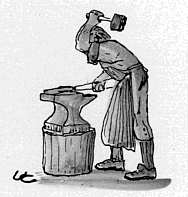

first published in Blacksmith & Wheelright, 1896
republished in ANVIL Magazine, January 1998
The opinion is expressed by a writer in the Mechanical News that the forge and furnace of the future will consist of a lead-lined glass or porcelain vase, or cupola, filled with cold, acidified water, to which is connected a strong positive conductor, the forge and outfit being rendered complete by a pair of tongs with insulated handles attached to a flexible negative conductor. According to this plan, the smith seizes the piece of iron which is to be manipulated with the insulated tongs and plunges it into the sour water, which begins to boil and bubble the instant it comes in contact with the iron, the latter, in a remarkably short space of time, turning to a red and then to a white heat, ready for the work of the smith. So rapidly, indeed, is the heating done by this means that the water and the portion of the iron not immersed in the water are but slightly warmed. The principle involved in this process is of a simple and well-known character - resistance producing the light and heat - it being found that enormous heat can be produced by such a method, much greater, in fact, than is necessarv to extract iron from the most refractory ores. It is remarked that the value of such a process will be especially exhibited in the more complete and rapid handling of heavy iron and steel plates and bars requiring to be hammered and welded more valuable still for tempering purposes, as the necessary heat for the immersed portion can be so quickly obtained, while the remaining portion holds comparatively cool.
Return to the Anvil Commentary listing page.
Return to the ANVIL Online Table of Contents for January, 1998.